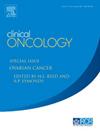Assessment of Clinical and Neurological Alterations Before Radiation Therapy in Children With Malignant Brain Tumours
IF 3
3区 医学
Q2 ONCOLOGY
引用次数: 0
Abstract
Aim
Young patients with a brain tumour (BT) show neurocognitive alterations as both consequences of the tumour and of the treatments received. In this paper we present the basal analysis of a patient’s series, correlating tumour localisation, symptoms, neurological/endocrinological impairments, surgery/ies ± chemotherapy, and cognitive assessments at the time of enrolment before focal-radiotherapy (RT).
Methods
Sixty-six children eligible for focal RT underwent a neurocognitive assessment. The demographic, pathological and clinical variables with MRI morphological scans, where different kinds of damage scores were defined, were analysed.
Results
The patientssmedian age was 8 years; the most frequent tumour was ependymoma (41%), and supratentorial (71%) was the prevalent site. All but 2 children (with germ cell tumours), had received surgery and 32 chemotherapy courses before irradiation. Ad-hoc scores for neurological deficits, endocrine alterations and structural abnormalities were created and applied. Patients with infratentorial tumours locations showed the highest score of neurological damage while endocrine alterations were more serious in patients with craniopharyngioma and germ cell tumours of the sellar region and ventricular system. The median number of damaged areas was equal to 2 for each child. Neurological deficit scores were not associated with hydrocephalus and surgery/ies received, unlike endocrine deficits. Tumour site, length of symptoms and endocrine alterations were found to be associated with cognitive impairment.
Conclusion
The pre-radiation evaluations highlighted that damages develop already prior to focal-RT. Specific scores may quantify damages that are generated by multiple factors that need to be considered over time after irradiation.
儿童恶性脑肿瘤放射治疗前临床和神经系统改变的评估
患有脑肿瘤(BT)的年轻患者表现出神经认知改变,这是肿瘤和接受治疗的结果。在本文中,我们介绍了患者系列的基础分析,将肿瘤定位、症状、神经/内分泌损伤、手术/手术±化疗以及在入组时进行局灶放疗(RT)前的认知评估联系起来。方法66例符合局灶性放射治疗条件的儿童接受神经认知评估。人口统计,病理和临床变量与MRI形态学扫描,其中不同种类的损伤评分被定义,进行了分析。结果患者中位年龄8岁;最常见的肿瘤是室管膜瘤(41%),幕上瘤(71%)是最常见的部位。除2名患有生殖细胞肿瘤的儿童外,所有儿童在放疗前均接受过手术和32次化疗。神经功能缺陷、内分泌改变和结构异常的特设评分被创建和应用。幕下肿瘤患者的神经损伤评分最高,而鞍区和脑室系统的颅咽管瘤和生殖细胞肿瘤患者的内分泌改变更为严重。每名儿童受损区域的中位数为2个。与内分泌缺陷不同,神经功能缺陷评分与脑积水和接受手术/手术无关。发现肿瘤部位、症状持续时间和内分泌改变与认知障碍有关。结论放疗前评价强调病灶放疗前损伤已发生。特定的评分可以量化辐射后一段时间内需要考虑的多种因素所产生的损害。
本文章由计算机程序翻译,如有差异,请以英文原文为准。
求助全文
约1分钟内获得全文
求助全文
来源期刊

Clinical oncology
医学-肿瘤学
CiteScore
5.20
自引率
8.80%
发文量
332
审稿时长
40 days
期刊介绍:
Clinical Oncology is an International cancer journal covering all aspects of the clinical management of cancer patients, reflecting a multidisciplinary approach to therapy. Papers, editorials and reviews are published on all types of malignant disease embracing, pathology, diagnosis and treatment, including radiotherapy, chemotherapy, surgery, combined modality treatment and palliative care. Research and review papers covering epidemiology, radiobiology, radiation physics, tumour biology, and immunology are also published, together with letters to the editor, case reports and book reviews.
 求助内容:
求助内容: 应助结果提醒方式:
应助结果提醒方式:


